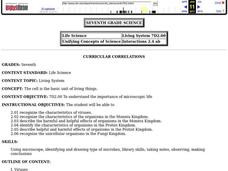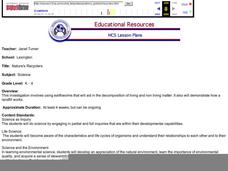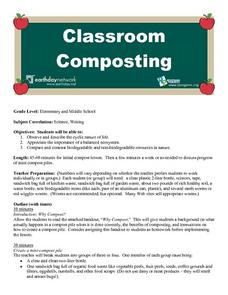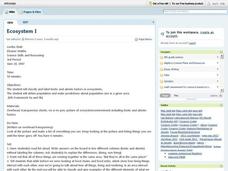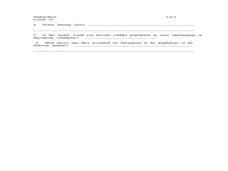Curated OER
The Animal Kingdom of Vertebrates
Seventh graders classify fish according to their characteristics. In this classification lesson students learn how to group animals including birds, reptiles and amphibians.
Curated OER
Cells
Seventh graders look up pictures of viruses or pictures of models of viruses. Using pipe cleaners, beads, Styrofoam or other available materials make models of these shapes. They then observe a demonstration to show the effect of Tobacco...
Curated OER
Microarrays: Chipping Away at the Mysteries of Science and Medicine
High schoolers research microarrays on the internet in cooperative groups. Students write an essay describing the use of microarrays in environmental research and in medicine.
Curated OER
Nature's Recyclers
Learners create environments to demonstrate how earthworms interact with their surroundings.
Curated OER
Create a Soil Aggregate
Students simulate the conditions which occur in a soil aggregate. They explain how IPM affects the environment. They identify the cast of characteristics to develop their aggregate.
Curated OER
Save A Reef!
Students identify the major threats to coral reefs and the ways that they benefit from humans. In this coral reef conservation lesson students create a public education program on coral reefs.
Curated OER
What Role Do Forest Play in Continuing or Renewing Our Planet's Resources?
Students explore the interaction between the forest and wildlife. In this forestry lesson, students collect data about forest ecosystems, species of trees, photosynthesis, and interaction of organisms. They prepare a lab activity to...
Curated OER
Mother Earth
Students compare natural and human made items and gain an awareness of the importance of Mother Earth to the Nez Perce people.
Curated OER
Classroom Composting
Students discover the benefits of composting. They identify the steps of decomposition as well. They are read a book and discuss what items decompose.
Curated OER
Totem Poles -- Storytellers of Long Ago
Third graders discover the main purpose for totem poles was to communicate with others. In groups, they compare and contrast the four types of totem poles and the various symbols used. They write their own stories based off of pictures...
Curated OER
Simple Machines
First graders discuss work, force, and energy. They study how work is done. Students discuss various types of work that are done. They act out how work is done. Student draw pictures of types of work they have done.
Curated OER
Ecosystem I
Learners classify and label biotic and a-biotic factors in ecosystems. They define population and make predictions about population size in a given area. They describe the a-biotic factors' importance and impact on the other elements...
Curated OER
Water and Ice
Learners examine how water changes state, from a liquid to a solid. In this water lesson students study the water cycle and how temperature and pressure effect it.
Curated OER
Oh Panther
Learners play a game that replicates the balance of prey and predators in an ecosystem. In this physical education lesson plan, students follow the instructions to play "Oh Panther!" Learners collect data regarding the game and discuss...
Curated OER
Let's Sort a Salad
Students examine edible plants by identifying salad ingredients. In this botany lesson, students discuss the different vegetables that can be eaten in a salad and draw them on a worksheet. Students review vegetable vocabulary and examine...
Curated OER
Beans Are Seeds
Second graders read literature regarding the growth of seeds. They investigate how seeds need water and light to sprout and then grow. They experiment by planting their own bean seeds. They record the progress of their seeds in both...
Curated OER
Water Under the Bridge
Students consider how much water they use on daily basis by investigating and recording their own patterns of water use over two weeks, and discover ways to begin conserving water in their own homes. Culminating field trip to local creek...
Curated OER
Air and Water in the Environment
Second graders participate in a three part lesson in which they identify and describe forms of moisture in the environment. Part one of the lesson involves the three stages of the water cycle, part two focuses on creating humidity by...
Curated OER
Alien Invasion
Students research how alien species can change an ecosystem. In this coral reef lesson plan, students describe invasive species and site evidence how these species came to be invasive and what control measures are possible.
Curated OER
Lesson Plan fo The Magic Eyes of Little Crab
Interested in a "how and why" story to read with young students? In this storytelling lesson, readers will discuss sea creatures, focusing on practicing new terminology through retelling the story. This resource provides a list of...
Curated OER
Including the Disabled Student
Learners read and discuss the history of special education in public schools related to the Individuals with Disabilities Education Act. Students work in groups to design ways to modify classroom activities based on the needs of a...
Clean Up Australia
Why are Batteries Harmful to the Environment?
Open this lesson by reading together about primary and secondary batteries (such as nickel-cadmium cells), problems they can cause in the environment, and how humans can minimize the damage. Afterward, little ones examine a collection of...
Curated OER
Stereotyping of Native Americans
Here is a lesson that covers the stereotyping of Native Americans in American culture is here for you. Learners see that there are many instances of stereotyping that are an accepted part of our society. After a lengthy discussion, a...
Curated OER
Center for Northwestern Art: Featured Objects
Each of the slides in this presentation provide learners with an image found at a northwestern art museum and a critical analysis of what can be seen in each piece. Learners can view this prior to a museum trip in order to build...
Other popular searches
- Living and Non Living Things
- Living and Non Living Things
- Living vs Non Living Things
- Living Non Living Things
- Living Non Living Things
- Laving and Non Living Things
- Living Non Living Organisms
- Living vs. Non Living Things
- Living vs Non Living Things
- Lving and Non Living Things
- Living, Non Living Things
- Living/non Living Things



